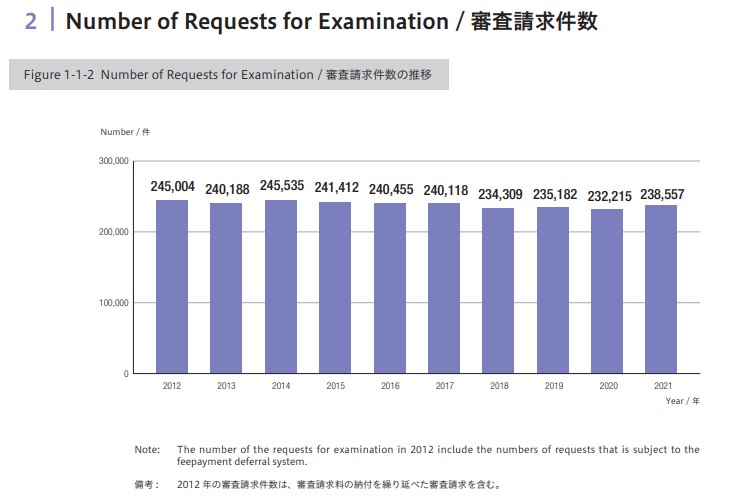Every year the Japan Patent Office (JPO) publishes a status report in spring, and this year’s report (the “Status Report 2022”) was published on March 30, 2022. The Status Report 2022 contains statistics on Japanese and worldwide IP trends, and information on the JPO’s initiatives to protect industrial property rights and to promote innovation. The report is in both English and Japanese and can be found here.
Below are some statistics related to patents in Japan, which we picked up from the Status Report 2022.
1. Number of patent applications, requests for examination, and patent registrations
Overall, the number of patent applications, requests for examination, and patent registrations have decreased in Japan over the past ten years[1]pages 12 and 13 of the Status Report 2022.
The number of patent applications dropped in 2020 and the trend continued in 2021. We will have to carefully watch the number of patent applications in 2022 in order to assess whether the decrease was due to the Covid-19 situation or for any other reason.

Despite the decrease in the number of patent applications, the number of requests for examination remained stable. Companies may be carefully choosing the inventions for which they will file patent applications. The number of patent registrations also remained steady after seeing a significant drop in 2014 and further down in 2015.

2. Number of appeals against an examiner’s decision of refusal and the rate of success in such appeal
The number of appeals against an examiner’s decision of refusal has decreased[2]page 30, but on the other hand, the rate of appeals succeeded has increased[3]page 31 over the past ten years. The rate was as high as 77% in 2021, marking a large increase by 7% from the figure 70% in 2020. The increase might be attributed to the fact that companies carefully selected inventions for patent applications and the JPO’s recent user-friendly attitude. At any rate, it is clear that an applicant should not be pessimistic even if he/she received a decision of refusal as to his/her patent application.


3. Number of requests for invalidation trials
The number of requests for invalidation trials has decreased significantly over the past ten years, and is now less than half compared to the figure in 2012[4]page 31. At least some part of the decrease may be attributed to the re-introduction of post grant opposition proceedings in 2015.

4. Number of post grant oppositions
The number of post grant oppositions against patent grants, which was re-introduced from April 2015, seemed to be in decline in the past few years but suddenly increased in 2021[5]page 33. We do not know yet whether this increase will be a continued trend or a mere isolated phenomenon.

5. First action pendency and total pendency
The first action pendency (the period from the date of examination request until the JPO issues the first Office Action on the merit) was on average 10.2 months in 2020. The total pendency (the period from the date of examination request to withdrawal or abandonment or a final disposition, excluding cases where the JPO sends a second office action with respect to amendments submitted by the applicant, and where the applicant takes procedures such as requesting an extension of time to file the response, requesting an accelerated examination, etc.) was on average 15.0 months in 2020[6]page 47. The short FA pendency and short total pendency are in line with JPO’s aim to achieve the “world’s fastest and utmost quality patent examinations.”

________________________
To make sure you do not miss out on regular updates from the Kluwer Patent Blog, please subscribe here.

References

